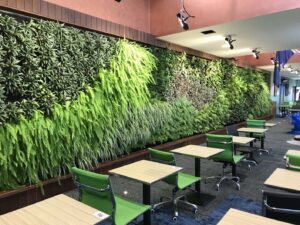Greening cities gets a boost with a new Green Infrastructure industry body
By Michael Casey
With more than 70% of the global population projected to be living in cities by 2050, coupled with the need to meet sustainability targets in 2030 and 2050, government and city planners will have to rethink how the future of cities will need to look and work. Planners, developers and architects will need to do the same with the design and build of the grey environment.
With numerous cities around the world all facing challenges related to climatic change, loss of biodiversity and ecosystems, flooding and heatwaves along with the increase in urbanisation, this presents some serious issues such as poverty, a decrease in wellness and rising socioeconomic inequality and in some cases, serious health issues.
Thankfully, city decision makers and planners are recognising that Nature Based Solutions (NBS), which uses many forms of green infrastructure such as green walls, green roofs, and storm water mitigation installations, are becoming critical in protecting, sustainably managing, and restoring natural or modified ecosystems.
The complexities that are presented with the design of urban landscapes and grey infrastructure is that they are an interconnected system. The built environment will modify hydrology and climate and can inhibit the use of Green Infrastructure solutions due to space constraints. These complexities are a shared challenge to solve, not just for planners and developers, but for the greening industry itself who needs to be informed on how to ensure successful integration of green solutions and how they will work to deliver the various benefits that will follow.
With a shared challenge, comes the need for centralisation of information that can act as a single source and one that is fit for (local) purpose/conditions. By sharing and transferring this knowledge, it provides a clear path forward for the integration of green infrastructure solutions.
I have worked in the green infrastructure sector for an extended period, and have written various articles in Hort Journal detailing urban greening projects and updates within the industry. Pleasingly, after many years of industry collaboration and work that started with the Roadmap for green roofs, walls and facades in Australia’s urban landscapes 2020-2030, the green infrastructure sector can proudly introduce its new industry body. The Australasian Green Infrastructure Network (AGIN) which has been formed to bring government, industry, and researchers together, to facilitate the scalable adoption of green infrastructure such as green roofs, walls and facades in Australia and New Zealand.
AGIN, which was officially incorporated as an association in November 2022, has been gathering strong support both here and around the world. Here in Australia, the organisation is being supported by the assistance of over 30 passionate green infrastructure professionals from the private and government sectors, research and associated industries.
Jess Miller, former deputy lord mayor of Sydney and founder of Greener Spaces, Better Places says, “The future livability of our cities depends on the creativity, expertise and collaborative efforts of professionals who understand living systems. The Australasian Green Infrastructure Network are just those people. The formation of this association is timely, necessary, and hopeful. I can’t wait to see what results from their collective efforts.”
World-leading urban greening expert, Dusty Gedge, Director of Livingroofs.org and UK Green Roof Organisation board member, is thrilled at the prospect of this new Australian industry group; “Green infrastructure addresses the challenges of urbanisation and climate change in cities and is best supported by active industry associations. It’s great to see the establishment of the Australasian Green Infrastructure Network”.
Co-founders Ben Nicholson and Gail Hall are no strangers to the world of green infrastructure, as both worked side by side at the City of Melbourne in the green infrastructure department. Hall developed the Growing Green Guide and green policy, including the creation of the Green Factor Tool, an intuitive web-based tool designed for the City of Melbourne, to benchmark building-scale green infrastructure, whilst Nicholson has contributed to greening Melbourne’s laneways and providing technical expertise on constructing green roofs, walls, and facades.
Ben Nicholson says, “We are forming this industry body to provide a platform for ‘urban greeners’ who want to make a difference and create positive change. There is so much amazing work being done by people in government departments, at universities and in the green infrastructure industry, but it lacks an active central body to coordinate and drive further change”.
The vision for AGIN is to promote healthier, liveable, climate-resilient communities through the uptake of green infrastructure which is a proven key solution to the challenges of urban growth and climate change in the southern hemisphere.
It has been well-researched that urban green infrastructure or nature-based solutions can benefit cities in multiple ways, including:
● Reducing heat and surface temperatures
● Improving air quality by removing harmful pollutants
● Enhancing biodiversity
● Reducing noise
● Absorbing stormwater runoff which reduces flash flooding and pollutants entering our waterways
● Advancing health and wellbeing
Much like other industry associations/bodies, being affiliated with AGIN provides direct access to the latest industry thinking and insights around important issues like building trends, environmental discussions, best practices, green infrastructure projects and up-to-date research. Similarly, it provides great networking opportunities, which is especially important given our industry is a multi-disciplinary profession, where there’s an opportunity to associate with other professions working in this sector. This can positively contribute to open debate/discussion, and reaching consensus on complex issues.
For further information or hearing about future updates and networking events, reach out to the team at hello@AGIN.org.au
Michael Casey,
Director of Evergreen Infrastructure and MJC Horticulture
Advisor to the green infrastructure industry
M: michael@evergreeninfrastructure.com.au
Main photo: Green wall constructed by Evergreen Infrastructure (Image: Michael Casey)

